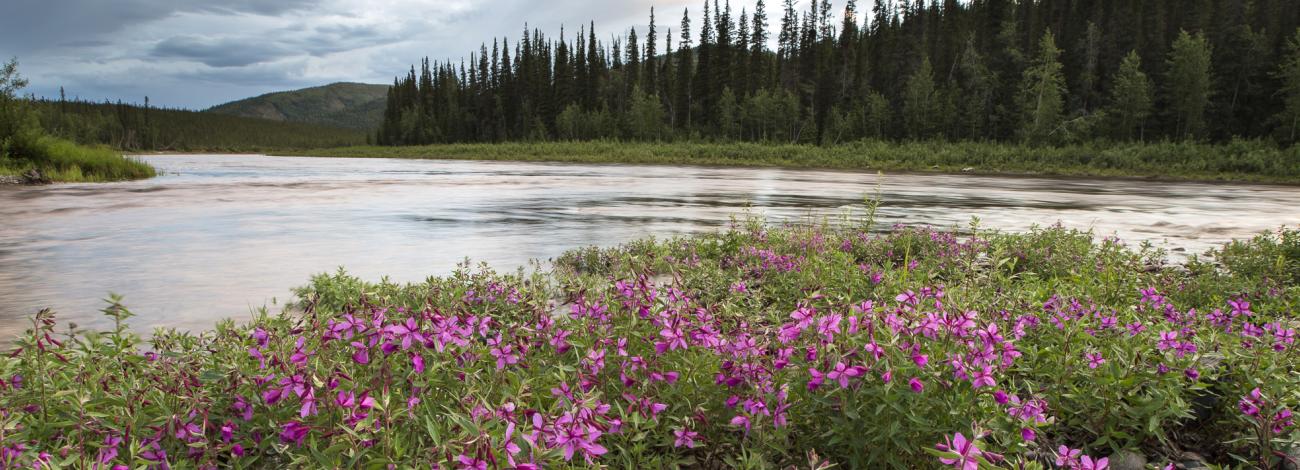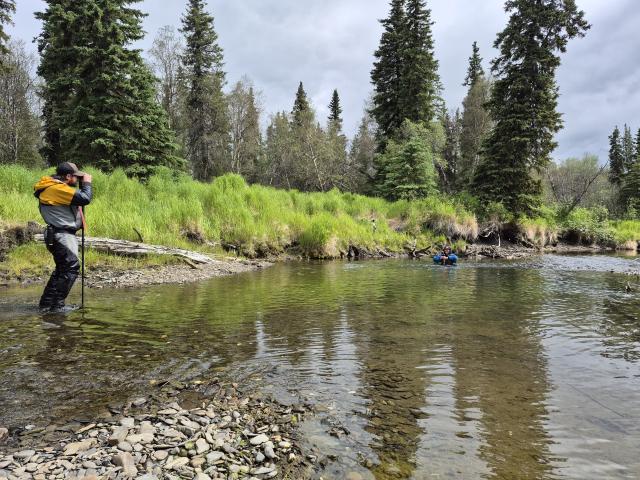
Gravel to Gravel: Supporting Healthy Salmon Habitat
Salmon are a key component of Alaska’s ecosystems, cultures, communities, and local economies. As a renewable natural resource, sustaining healthy salmon habitats supports the BLM’s mission of responsible, balanced stewardship of public lands and resources.
In recent years, long-term declines in Chinook salmon and sharp declines in chum salmon—particularly in the Yukon, Kuskokwim, and Northern Bering Sea regions—have led to closures of both commercial and subsistence fisheries. These closures have deeply affected food security, cultural practices, and local economies in communities that have depended on salmon for generations.
To address these challenges, the BLM is working in close coordination with the U.S. Fish and Wildlife Service, Alaska Native Tribes, the State of Alaska, other federal and state agencies, and local partners. Through the Gravel to Gravel Initiative, partners are implementing projects that enhance ecosystem resilience and support salmon recovery in the Yukon, Kuskokwim, and Northern Bering Sea regions. This work includes habitat conservation, collaborative research, and efforts to reduce threats to food security.
BLM-managed lands play a critical role in supporting salmon populations across Alaska. About 11,000 miles of streams and rivers flow through these lands, providing critical spawning, incubation, and rearing habitats for salmon harvested in subsistence, sport, and commercial fisheries.
Important salmon waters on BLM-managed lands include:
Yukon River Basin: Innoko, Bonasila, Anvik, Nulato, and Tozitna Rivers
Koyukuk River Tributaries: Gisasa, Kateel, Hogatza, and South Fork Koyukuk Rivers
Kuskokwim River Basin: George, Tatlawiksuk, Swift, and Middle Fork Kuskokwim Rivers
Wild and Scenic Rivers: Unalakleet River, Birch Creek, Beaver Creek, and the Fortymile River
Salmon returns to individual rivers vary widely from year to year, driven by dynamic environmental conditions in freshwater and marine environments. However, the diversity of salmon populations across large watersheds, like the Yukon and Kuskokwim, creates biological resilience, helping to stabilize overall returns. By working collaboratively across the vast Gravel to Gravel landscape, partners are supporting this diversity and strengthening the long-term sustainability of Alaska’s salmon fisheries.
The BLM is committed to improving watershed health through science-based assessment, restoration, and strong partnerships—ensuring that salmon continue to shape Alaska’s lands and communities for generations to come.
BLM's role in Gravel to Gravel
Expanded Habitat Assessment
The BLM monitors the condition and trend of stream habitats on BLM-managed lands using the National Aquatic Monitoring Framework. This science-based approach relies on statistically valid sample designs and consistent field sampling methods to inform decisions at the landscape level.
Stream habitat data collected on BLM-managed lands in Alaska has been key to understanding land use impacts and developing reference datasets for stream reclamation and restoration. As part of the Gravel to Gravel Initiative, BLM is expanding stream habitat monitoring across the Yukon, Kuskokwim, and Northern Bering Sea regions. This effort will assess current habitat conditions and provide the data needed to design and implement restoration projects.
Monitoring will include streams degraded by past human activity, helping to quantify impacts and prioritize restoration needs. BLM’s rigorous training program, open-access data portal, and analytical tools will support Tribes, agencies, and local partners in making informed, science-driven decisions.
Data collection initiated in 2025 in partnership with the Alaska Department of Environmental Conservation and the University of Alaska Anchorage. This past summer, field crews sampled 53 wadeable stream habitats in the Ahklun Mountains ecoregion in Southwest Alaska. The collected information will be available on BLM’s Assessment, Inventory, and Monitoring public data portal in January 2026. Future years will focus on additional ecoregions across the Gravel to Gravel landscape.
More information about BLM Alaska's work to expand habitat assessments across the Gravel to Gravel region can be found in BLM’s Factsheet: AIM-ing to Understand Stream Habitats.
A more in-depth overview of BLM Alaska's stream habitat assessment program can be found in BLM’s Factsheet: BLM’s Assessment, Inventory, and Monitoring Strategy.
Fish Inventories
Stream habitats in the Gravel to Gravel region support all five species of Pacific salmon along with other anadromous and resident fish species that are important to subsistence, sport, and commercial fisheries. However, limited information on the distribution of salmon habitats and life stages across this vast and remote landscape continues to hinder effective land management.
To address the data gap, BLM partnered with the Alaska Department of Fish and Game (ADFG) to inventory streams using traditional sampling equipment and emerging technology (e.g., environmental DNA). This project will improve our understanding of resident and anadromous fish species’ distributions within the Gravel to Gravel landscape.
Project planning began in 2024, with field sampling scheduled from 2025 through 2027. Updated fish inventory data will be posted annually to the ADFG Fish Resource Monitor web mapper.
Restoration of Degraded Streams
The Alaska gold rush of the mid-1800s to early 1900s brought a wave of mining activity that left lasting impacts on stream ecosystems. Historic mining practices like vegetation removal, stream rerouting, and soil erosion caused widespread habitat degradation. Alaska’s short growing season, periodic flooding, and repeated mining before the implementation of modern environmental laws have slowed natural recovery in many areas.
Legacy mining impacts are found across several watersheds on BLM-managed lands within the Gravel to Gravel landscape. Since 2013, portions of the upper Yukon River have been the focus of applied research and the application of new habitat rehabilitation techniques. These efforts have contributed to the creation of stream restoration datasets that will help improve future project success across the region and the publication of an interagency Stream Design Guide.
In partnership with the Salcha-Delta Soil and Water Conservation District, BLM continues to restore stream habitats in disturbed watersheds in Interior Alaska. Since 2023, 1.25 creek miles and 20 acres of floodplain habitat restoration work were completed on Nome Creek within the White Mountains National Recreation Area. This work will continue for many years within the 8-mile stretch of Nome Creek from the confluence of Sumner Creek downstream to the confluence with Moose Creek.
Since 2023 on Wade Creek, the BLM has improved over a mile of stream and nearly 15 acres of floodplain restoration.
Over the next decade, BLM will continue restoration efforts in the upper Yukon while also expanding into other areas of the Gravel to Gravel landscape. Besides implementing restoration projects on BLM-managed lands, agency staff also provide technical expertise and support to develop and implement stream restoration plans that enhance fish habitat, improve water quality, and strengthen overall watershed health. This includes offering guidance to placer miners on stream reclamation and fish habitat rehabilitation.
Streamlining Riverscape Restoration
Legacy land use practices from the late 1800s through the mid-1900s continue to limit aquatic habitat productivity in parts of Alaska. Addressing these impacts requires careful planning, funding, and regulatory compliance—particularly under the National Environmental Policy Act (NEPA), which mandates environmental review of proposed projects. While essential, this process can delay restoration efforts.
To streamline future compliance, BLM developed a programmatic environmental assessment to guide aquatic and riparian habitat restoration on BLM-administered lands in Alaska. This document is designed to increase the pace and scale of restoration work.
The programmatic analysis covers up to five miles of stream restoration annually and includes a range of activities such as in-stream and floodplain enhancements (pond, lake, and wetland restoration), the addition of large woody debris and other in-stream structures, streambank enhancement, head-cut stabilization, restored channel alignment, and plantings and vegetation treatments.
Invasive Species Management
Aquatic invasive species, such as Elodea, present a significant risk to salmon streams since this plant affects the quality of habitat for juvenile salmon.
A strong commitment to early detection through invasive species inventories and rapid response to new infestations can stop invasive species from gaining a foothold in salmon streams. Early detection and rapid response are critical steps for reducing invasive species risks in Alaska and ensuring the resiliency of our aquatic ecosystems.
In 2024, BLM partnered with Soil and Water Conservation Districts to inventory several Wild and Scenic River units. Other work included the completion of weed-free gravel certifications at mineral material sites to stop the spread of invasives by one of the most common vectors. The development of an invasive species management plan is in development.
Current partners
- U.S. Fish and Wildlife Service
- Trout Unlimited
- Alaska Department of Fish and Game
- Alaska Department of Environmental Conservation
- University of Alaska
- Salcha-Delta Soil and Water Conservation District
- National Park Service
- U.S. Geological Survey


